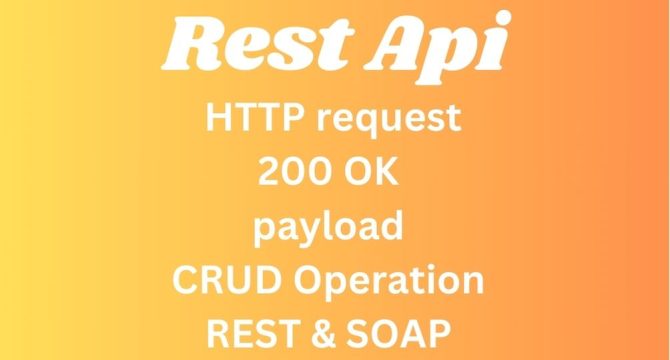Rest api mostly popular to develop the Web and mobile application. Basically ist used to connect to different services or systems , Like as: databases, storage, and messaging systems. Suppost that if you want to create,read,update or delete the data of any application or software by using internet them you can use the rest api.
In this session, we’ll go through important REST API questions you should know how to answer when interviewing for a web developer position, including some broad questions and others that may require more in-depth,technical responses. You can clear different questions of Rest api like as: What is Rest api ? or Different between Rest and Soap api ? or What is a payload? or What is the most common HTTP status codes extra…

Table of Contents
Toggle1). What is REST?
REST stands for Representational State Transfer, and is an architectural style based on the Hypertext Transfer Protocol (HTTP) for developing web-based applications.
2. What is a REST API ? or Rest API. (Imp Question)
An application programming interface (API) is a software-to-software interface that allows otherwise separate applications to
interact and share data.
Rest is a set of principles for creating simple, scalable, and flexible systems that can interact and share data over a network.
REST APIs are stateless, resource-based, and leverage a standardized set of HTTP methods for client and server communication.
REST is the most popular API architectural style and the foundation of the web.
3). What’s the difference between REST and RESTful? (Imp Question)
The word “RESTful” describes APIs or services that adhere to REST principles. To be RESTful, a service or API must follow the rules and best practices defined by REST, such as properly using HTTP methods and representing resources as URLs. Being RESTful also entails hiding server implementation details from clients, which promotes flexibility and scalability. In a RESTful design,
efficient caching techniques can also minimize unnecessary data transfers and boost performance.
4). What are the different components of an HTTP request? (Most Imp Question)
The most basic REST APIs use standard HTTP methods like POST, GET, PUT, and DELETE to perform Create, Read, Update, and
Delete (CRUD) operations on resources that are represented by URLs.
An HTTP request includes four major pieces of information:
Method: A standard verb that describes the action being applied to the resource, such as POST, GET, PUT, or DELETE.
Uniform Resource Identifier (URI): Identifies the resource on the server. A URI, which is also known as an API endpoint, can be either a relative or absolute path, and it may contain data like path or query parameters. For example, /products might identify a list of products, /products?type=book might identify books within the product list, and /products/1234 might identify a specific book.
Request headers: Contain metadata about the request as key-value pairs. For instance, these HTTP headers might include the type of client or browser, the client-supported format, the message body format, and cache settings.
Request body: The payload, which is usually JSON or XML data, that is sent to the server. For example, if you send a POST request to /products, the request body will contain the data for the product you want to create.
5). What are the different components of an HTTP response?
An HTTP response includes three major components:
HTTP status code: Indicates the outcome of the request, such as 200 OK for success.
Response headers: Contain metadata about the response, including information like the content type, server details, and
caching directives.
Response body: The payload that the server sends in response to the request.
For example, this could be HTML from a web page, or it might be JSON or XML data from an API.
6). What is an HTTP status code?
An HTTP status code is a three-digit numeric code that a server returns as part of an HTTP response.
The code provides information about the result of the request. For example, a successful request usually returns a 200 OK
status code, while an unsuccessful request might return a 404 Not Found status code. HTTP status codes are organized into classes: codes in the 200s are successful, 300s indicate redirection, 400s signify a consumer or client error, and 500s point to a provider or server error.
7). What are the most common HTTP status codes you see when working with REST APIs? (Most Imp Question)
These are some of the most common HTTP status codes:
200 OK
201 Created
204 No Content
400 Bad Request
401 Unauthorized
403 Forbidden
404 Not Found
500 Internal Server Error
503 Service Unavailable
8). What is a payload? (Imp Question)
In the context of APIs, the payload is what goes in the body of the request or response.
It contains the data that is sent as part of an API request or response using a POST or GET method.
The payload contains the actual information being sent, such as JSON or XML data.
9).What is CRUD ? or What is CRUD operation in Rest api ? (Most Imp Question)
CRUD is an acronym representing the four basic operations commonly performed in a relational database. REST supports each method in CRUD via the HTTP protocol.
CRUD stands for:
Create: POST method in REST for creating new database record
Read: GET method in REST for reading information from a database
Update: PUT method in REST for updating an object in database
Delete: DELETE method in REST to remove an item from a database
10). What is SOAP? or What is SOAP api ? (Imp Question)
SOAP is an acronym for Simple Object Access Protocol and is a messaging protocol that relies on the XML data format to request and respond to messages. It solely depends upon the XML schema and other technologies to implement its payload functionality.
SOAP also utilizes the Remote Procedure Call (RPC) pattern, where functions return results only after a parameter is passed. Additionally, both SOAP and RPC use XML to exchange data.
11). What is the difference between REST and SOAP? (Most Imp Question)
|
No. |
SOAP |
REST |
|
1) |
SOAP is a protocol. |
REST is an architectural style. |
|
2) |
SOAP stands for Simple Object Access Protocol. |
REST stands for REpresentational State Transfer. |
|
3) |
SOAP can’t use REST because it is a protocol. |
REST can use SOAP web services because it is a |
|
4) |
SOAP requires more bandwidth and resource than REST. |
REST requires less bandwidth and resource than SOAP. |
|
5) |
SOAP defines its own security. |
RESTful web services inherits security measures from |
|
6) |
SOAP support only XML data format only. |
REST support different data format such as Plain text, HTML, XML, JSON |
|
) |
SOAP is less preferred than REST. |
REST more preferred than SOAP. |
12). What is API authentication and how does it work?
API authentication is the process of verifying that an API user has permission to access the data and resources they are
requesting. It works by denying or blocking access to servers for unauthorized users when an identity mismatch occurs.
Example: if you were to provide the wrong username, password, or another form of credential, then the API would be unable to
verify your right to access data within its server.
API authentication is an excellent security layer that prevents cybercriminals from launching attacks on vulnerable systems.
13). Why is versioning important in API design?
Versioning is crucial to API design because it helps maintain compatibility, offer stability, and reduce disruptions. Versioning also enables incremental updates, supports a wide range of clients, and fosters user and developer confidence. By isolating changes, versioning ensures that existing clients won’t break when improvements or fixes are introduced, which allows for smooth and controlled evolution of the API while encouraging adoption and clear communication about updates and deprecation plans.
14). What is API testing? (Imp Question)
API testing is a software testing strategy that ensures APIs are stable, functional, reliable, and secure.
API testing works by analyzing the business logic, security, application, and data responses. An API test is generally performed by sending requests to one or more API endpoints and weighing them with expected results.
Examples:
Validation
Security testing
UI testing
Functional testing
Load testing
Penetration testing
Runtime/error detection testing
Integration testing
Fuzz and interoperability
Unit testing
15). Name some API testing tools.
These are the popular API testing tools:
Katalon is a test automation tool that supports SOAP and REST requests
Postman is used to test REST APIs and provides an interface for making HTTP requests and viewing the response
SoapUI Pro is used to test SOAP-based APIs
Apigee can be used to test both SOAP-based and RESTful APIs
16). What is Runscope?
Runscope is a web application used to monitor, debug, and performance test web service APIs. It provides an accessible interface and backend services to test APIs to ensure they work optimally.
—————————————————————————————————————————————————————————————————————————————————————————–People also ask- rest api interview questions | Top REST API Interview Questions and Answers (2024) | rest api interview questions for experienced | rest api interview questions javatpoint | what is rest api interview questions | what is rest api interview questions | rest api interview questions javatpoint | rest api interview questions for experienced developers | rest api interview questions for testers | rest api interview questions github | rest api interview questions salesforce | rest api interview questions pdf | rest api interview questions geeksforgeeks | common rest api interview questions | top rest api interview ques | restful api interview questions | restful api interview questions for experienced | rest api interview questions for experienced developers | rest api interview questions for testers | what is rest interview questions | why do jobs do exit interview
